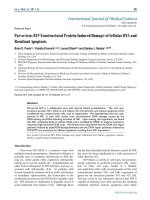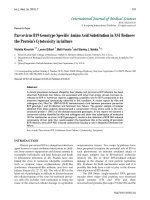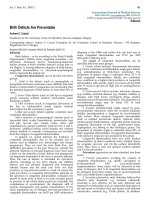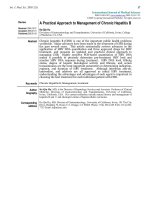Báo cáo y học: "Parvovirus B19 Nonstructural Protein-Induced Damage of Cellular DNA and Resultant Apoptosis"
Bạn đang xem bản rút gọn của tài liệu. Xem và tải ngay bản đầy đủ của tài liệu tại đây (484.56 KB, 9 trang )
Int. J. Med. Sci. 2011, 8
88
I
I
n
n
t
t
e
e
r
r
n
n
a
a
t
t
i
i
o
o
n
n
a
a
l
l
J
J
o
o
u
u
r
r
n
n
a
a
l
l
o
o
f
f
M
M
e
e
d
d
i
i
c
c
a
a
l
l
S
S
c
c
i
i
e
e
n
n
c
c
e
e
s
s
2011; 8(2):88-96
© Ivyspring International Publisher. All rights reserved.
Research Paper
Parvovirus B19 Nonstructural Protein-Induced Damage of Cellular DNA and
Resultant Apoptosis
Brian D. Poole
1,2
, Violetta Kivovich
1,3,4,5
, Leona Gilbert
4,5
and Stanley J. Naides
1, 5,6
1. Huck Institute for Life Sciences, Pennsylvania State University College of Medicine/Milton S. Hershey Medical Center,
Hershey, PA, USA
2. Current: Department of Microbiology and Molecular Biology, Brigham Young University, Provo, UT, USA
3. MD/PhD Program, Pennsylvania State University College of Medicine/Milton S. Hershey Medical Center, Hershey, PA,
USA
4. Chemical Biology Division, Department of Biological and Environmental Science, University of Jyväskylä, Jyväskylä,
Finland
5. Division of Rheumatology, Department of Medicine, Pennsylvania State University College of Medicine/Milton S.
Hershey Medical Center, Hershey, PA, USA
6. Current: Quest Diagnostics Nichols Institute, San Juan Capistrano, CA, USA
Corresponding author: Stanley J. Naides, MD, Immunology, Quest Diagnostics Nichols Institute, 33608 Ortega Highway,
San Juan Capistrano, CA 92690. Tel. 949 728-4578; fax 949 728-7852; email:
Received: 2010.12.02; Accepted: 2011.01.13; Published: 2011.01.15
Abstract
Parvovirus B19 is a widespread virus with diverse clinical presentations. The viral non-
structural protein, NS1, binds to and cleaves the viral genome, and induces apoptosis when
transfected into nonpermissive cells, such as hepatocytes. We hypothesized that the cyto-
toxicity of NS1 in such cells results from chromosomal DNA damage caused by the
DNA-nicking and DNA-attaching activities of NS1. Upon testing this hypothesis, we found
that NS1 covalently binds to cellular DNA and is modified by PARP, an enzyme involved in
repairing single-s t r a n d e d D N A n i c k s . W e f u r t h e r m o r e d i s c o v e r e d t h a t t h e D N A n i c k r e p a i r
pathway initiated by poly(ADPribose)polymerase and the DNA repair pathways initiated by
ATM/ATR are necessary for efficient apoptosis resulting from NS1 expression.
Key words: Parvovirus B19, DNA damage and repair, fulminant liver failure, apoptosis, autoan -
tibody, systemic lupus erythematosus
Introduction
Parvovirus B19 (B19) is a common virus with
multiple clinical presentations. Infection in children is
typically seen as erythema infectiosum,
or fifth dis-
ease (1), while adults often experience arthropathy
lasting up to several months (2). Autoantibodies are
often found subsequent to B19 infection, and are as-
sociated with arthropathy (3-5). In patients with
chronic hemolytic anemias,
such as sickle cell disease
or hereditary spherocytosis, the destruction of the
e r y t h r o i d p r e c u r s o r p o o l b y B 1 9 l e a d s t o a p l a s t i c c r i s i s
(6). B19 infection is implicated in hepatitis non-A-E
acute fulminant liver failure (7-16). Although these
are the best-described
clinical illnesses caused by B19,
the virus has been implicated
in a wide spectrum of
other illnesses (17).
B19 infects a variety of cell types, but predomi-
nantly replicates in erythroid precursors (18). Infec-
tion of other cell types results in a limited,
non-replicative state with overexpression of the viral
nonstructural protein, NS1, and little expression of
genes for the structural proteins VP1 and VP2 (19).
Previous work in our laboratory showed that B19 is
capable of infecting liver cells, and that the resulting
restricted infection induces apoptosis, most likely
Int. J. Med. Sci. 2011, 8
89
through the action of NS1 (19, 20). NS1 is cytotoxic
when transfected into erythroid cells (21), COS-7 cells
(22) and liver-derived cells (20). In cell types which
are non-productive for viral infection, NS1-induced
apoptosis proceeds in a caspase 9-dependent manner,
indicative of internal apoptotic stimuli (20, 22).
The NS1 protein of parvovirus B19 exhibits mul-
tiple functions, with NTP binding, helicase, nickase,
and transcription factor activities (23-25). Because of
these DNA-modifying activities, we hypothesized
that NS1 induces apoptosis by damaging cellular
DNA. Apoptosis resulting from DNA damage would
be consistent with the caspase-9-dependent apoptotic
pathway (20, 22).
This hypothesis is supported by the act ion of
NS1 proteins from similar parvoviruses. The non-
structural proteins from the parvoviruses minute vi-
rus of mouse (MVM) and H-1 parvovirus also utilize
helicase and DNA binding activities to fulfill their
functions in viral replication (26-29). NS1 from MVM
binds covalently to the viral genome as part of the
replication process (29, 30). In addition, NS1 from
MVM and H-1 p a r v o v i r u s c o l o c a l i z e s w i t h t h e c e l l u l a r
DNA repair machinery (31-33). Covalent attachment
to cellular DNA would cause a significant lesion, as
would the introduction of multiple single-strand
breaks. DNA damage due to the actions of NS1
would be expected to result in apoptosis in a portion
of infected cells.
This study utilized cloned NS1 under the control
of an inducible promoter to examine the mechanisms
of NS1-induced apoptosis. The NS1 DNA sequence
was fused to that of green fluorescent protein (GFP)
( />ndsp1gfp.pdf) to allow visualization and purification
of NS1 (GFP/NS1). Cellular expression of this vector
has previously been shown to induce apoptosis in the
same manner as infection with natural B19, while a
mutant of NS1 with the NTP binding region deleted
induced significantly less apoptosis (20). The
GFP/NS1 vector was utilized in this study to inves-
tigate the role of the DNA-damaging activities of NS1
in NS1-induced apoptosis.
There are several mechanisms through which
NS1 could cause DNA damage resulting in apoptosis.
We hypothesized that NS1 could covalently attach to
chromosomal DNA, in much the same way that the
nonstructural proteins of MVM and H-1 parvovirus
attach to the viral genome. Covalent attachment of
NS1 to cellular DNA was investigated in this study
usi ng den atu ri n g SDS-PAGE and autoradiography.
Attachment of NS1 to DNA would be expect e d t o
initiate the DNA repair pathways that sense distor-
tions in the DNA helix. These pathways were ex-
amined by inhibition of the key proteins ataxia telan-
giectasia related (ATR) and ataxia telangiecta-
sia-mutated (ATM). The DNA-nicking activity that
NS1 uses to separate viral genomes would be ex-
pected to activate the single-strand break DNA repair
pathway if applied to host cell DNA. This pathway
was investigated by studying the activity of
Poly(ADP-ribose)Polymerase (PARP), the protein
which detects nicks in DNA and activates the repair
process.
Both the nick repair and ATR/ATM-mediated
bulky adduct repair pathways can result in apoptosis
if the damage is severe. Damage of chromosomal
DNA by parvoviral proteins has not been directly
demonstrated, except in the case of specific integra-
tion of AAV. We present here evidence suggesting
that NS1 is attached to DNA in a covalent manner,
and that both DNA-helix distorting and single strand
nick forms of DNA damage are important pathways
to apoptosis upon expression of NS1.
Materials and Methods
Transfection
A GFP/NS1 expression vector under the control
of the ecdysone response element previously con-
structed in our laboratory was utilized for these ex-
periments as previously described (20). Briefly,
HepG2 cells were grown on glass coverslips in hepa-
tocyte wash medium (Invitrogen, Carlsbad, CA) sup -
plemented with 10% fetal calf serum. Either
GFP/NS1 or the parental vector, pIND(GFP)SP1 (In-
vitrogen) was cotransfected with the ecdysone recep -
tor plasmid pVGRXR (Invitrogen) into the cells using
Lipofectamine (Invitrogen) and PLUS reagent (Invi-
trogen). Expression of GFP/NS1 or GFP was induced
by the addition of 10 µg/ml ponasterone A (Invitro-
gen). Protein expression was monitored by fluores-
cence microscopy.
Immunoprecipitation and chromatin immunoprecipitation
Cells expressing either GFP/NS1 or GFP were
lysed with 1% SDS in TE buffer. The lysate was cen-
trifuged through a Qiashredder (Qiagen, Valencia
CA) to shear DNA. Lysates were then mixed with 2
ml of 1% triton-X 100 (Fisher, Hampton, NH) in PBS
containing protease inhibitors (Sigma protease inhi-
bitor cocktail, Sigma-Aldrich, St. Louis, MO). 25 μl of
anti-GFP polyclonal antibody (Rockland, Gilberts-
ville, PA) were added and the mixture was allowed to
bind for 14 hours at 4
o
C i n a n en d-over end rotator.
Immune complexes were bound to protein G-agarose
beads (Pierce, Rockford, IL) for three hours at 4
o
C.
Immunoprecipitates were washed 5x with 1% triton-X
100 in PBS, and once with PBS alone, and boiled for 5
Int. J. Med. Sci. 2011, 8
90
minutes under reducing conditions in 1% SDS, 4M
urea and 0.7 M 2-mercaptoethanol. Immunoprecipi-
tates were electrophoresed on a 7.5-14% polyacryla-
mide gel and used for autoradiography and Western
blotting.
For chromatin immunoprecipitation, 10
7
cells
were cotransfected with pVGRXR and either
GFP/NS1 or pIND(GFP)SP1. Protein expression was
induced with ponasterone A 24 hours
post-transfection and the cellular DNA was metabol-
ically labeled with 10 µCui α
32
P thymidine triphos-
phate (Perkin Elmer) in supplemented hepatocyte
wash medium (Invitrogen). After immunoprecipita-
tion, one aliquot of each immunoprecipitate was
treated with 10 units DNase (Roche) for 1 hour at
37
o
C. After SDS-PAGE, proteins were transferred to
nitrocellulose and used to expose Kodak MS film to
obtain an autoradiograph image. GFP antibodies
were then used to identify the location of the trans-
genic protein by Western Blotting.
Western blotting
HepG2 cells were lysed in 1% (w/v) SDS, 4M
urea and 0.7M 2-mercaptoethanol. Lysates were
electrophoresed through 7.5-14% acrylamide gels
(BioRad, Hercules, CA). Proteins were transferred to
nitrocellulose membranes and bound with anti-GFP
polyclonal rabbit antiserum (Invitrogen) or poly(ADP
ribose) (PAR) monoclonal antibody (Pharmingen, San
Diego, CA) at 1:5000 dilution. Species-specific sec-
ondary antibodies (Amersham, Piscataway, NJ) were
used for detection with ECL+ chemiluminescence
(Amersham).
Detection of apoptosis
Transfected HepG2 cells were grown on glass
coverslips and stained with annexin-V-Alexa fluor
594 (Molecular Probes, Eugene, OR) as previously
described (19, 20). Transfected cells were identified
by green fluorescence and examined for apoptosis
using a 528-553 nm excitation filter and a 600-660 nm
barrier filter to allow for detection of the
red-fluorescing apoptosis marker. Apoptotic cells
also exhibited condensed nuclei when stained with
Hoescht 33342 (Molecular Probes).
Treatment with pharmacologic agents
Transfected HepG2 cells were pretreated with 8
to 14 mM caffeine (Sigma) for 3 hours before induc-
tion of protein expression. Caffeine was maintained
on the cells during expression of GFP or GFP/NS1.
PARP was inhibited by incubating transfected cells
with 5-aminoisoquinolinone (Calbiochem) at 250, 25,
2.5, and 0.25 μM concentrations 3 hours prior to
transgene induction. The inhibitor was maintained on
the cells throughout the experiment.
Statistical Analysis
The student’s T test (2-tailed) was used to eva-
luate significant differences in the experiments in -
volving inhibition of apoptosis, and the Pearson’s
correlation test was used to determine whether inhi-
bition was dose-dependent. P values of less than 0.05
were considered significant.
Results
Covalent attachment of NS1 to chromosomal DNA
Association of NS1 with chromosomal DNA was
detected using chromatin immunoprecipitation.
HepG2 cells were transfected with the GFP/NS1 ex-
pression vector or GFP vector alone and metabolically
labeled with
32
P-thymidine triphosphate during the
protein expression phase of the experiment. Labeled
DNA was detected by autoradiography and proteins
were detected by Western blotting. Radioactivity w a s
f o u n d i n s p e c i f i c b a n d s t h a t p e r f e c t l y o v e r l a p p e d w i t h
bands formed by GFP/NS1, but not GFP, as revealed
by Western blotting (Figure 1). The colocalization of
the radioactive signal with NS1 shows that DNA is
bound to NS1 in the lysate. The harsh denaturing
methods used both in the immunoprecipitation and in
the preparation of the samples for SDS-P A G E
strongly suggest that DNA could not have been
present with the NS1 fusion protein unless covalently
linked. Treatment of the immunoprecipitate with
DNase before SDS-PAGE decreased the radiographic
signal by 63%, indicating that the radioactive label is
DNA, and not from another source such as phospho-
rylation of NS1 (Figure 1).
Involvement of the DNA damage repair pathway
DNA damage normally blocks progression
through the cell cycle and, when severe, causes
apoptosis through the intrinsic or mitochondrial
pathway. Caffeine uncouples DNA damage from cell
cycle progression and apoptosis, primarily through
the inhibition of the DNA damage sensing protein
ATM and ATR, (34, 35). The involvement of the DNA
damage repair pathway in NS1-induced apoptosis
was examined in GFP/NS1-transfected cells by treat-
ing the cells with caffeine. Incubation of
GFP/NS1-transfected cells with caffeine inhibited
apoptosis in a dose-dependent manner, reducing the
percentage of apoptotic cells by nearly 70% at a con-
centration of 14 mM (Figure 2).
Int. J. Med. Sci. 2011, 8
91
Figure 1. DNA is covalently bound to NS1 protein. A. Autoradiography of GFP-immunoprecipitated
32
P labeled
c e l l s s h o w s r a d i o a c t i v e D N A c o l o c a l i z i n g w i t h G F P / N S 1 ( 1 0 0 k d ) , b u t n o t G F P a l o n e ( 3 7 k d ) , a f t e r b o i l i n g i n S D S w i t h u r e a
and β-mercaptoethanol. GFP and GFP/NS1 were detected by western blot. The blot shown is representative of 4 inde-
pendent experiments. B. Incubation of immunoprecipitates with DNase before the denaturation step abrogates the ra-
diographic signal by 63% (N=3 experiments, error bars indicate the range).
Figure 2. The ATM/ATR-mediated DNA repair pathways are necessary for efficient NS1-induced apopto-
sis. A. Caffeine treatment of GFP/NS1-transfected HepG2 cells led to a decrease in apoptosis of up to 63%, indicating the
necessity for ATR-dependent activity in apoptosis. The decrease in apoptotic caffeine-treated cells compared to cells
without caffeine treatment was significant by the student’s t test for the three concentrations. Pearson correlation analysis
comparing caffeine dose to apoptosis showed that the inhibition was dose-dependent (p<0.041). The data were derived
from 3 independent experiments. Error bars indicate the standard error of the mean.
Int. J. Med. Sci. 2011, 8
92
No difference was observed in apoptosis be-
tween the GFP-transfected cells and the untransfected
cells upon treatment with caffeine. The decrease in
apoptosis upon treatment with caffeine supports the
finding that NS1 induces apoptosis through DNA
damage that alters the chromatin structure.
Involvement of the DNA nick repair pathway
Although the ATM/ATR-dependent DNA re-
pair pathway is important in optimal NS1-induced
apoptosis, NS1 may also activate other DNA damage
repair pathways that can lead to apoptosis. Sin -
gle-strand nicks in genomic DNA would be expected
to activate PARP and the nick repair pathway. Acti-
vated PARP transfers Poly(ADP ribose) (PAR) to
neighboring proteins in response to DNA damage
(36-38). A s a m e t h o d of investigating the involvement
of PARP activation in NS1-induced apoptosis, the
NS1 fusion protein was examined for the presence of
activated PAR moieties, which would indicate the
presence of NS1 in a DNA lesion that was sufficient to
activate PARP, as well as demonstrating that the two
molecules, NS1 and PARP were in physical contact.
GFP/NS1 or GFP alone were immunoprecipitated
from transfected cells, and western blotting was per-
formed using an anti-PAR antibody. GFP/NS1 was
poly(ADP ribose)ylated, while GFP was not (Figure
3A). Poly(ADP ribose)ylation of NS1 shows that NS1
exists in the cell in contact with activated PARP, and
hence, in the presence of sufficient DNA nicks to ac-
tivate this repair pathway. To study the importance
of the PARP-initiated DNA repair pathway in
NS1-induced apoptosis, the cell-permeable PARP
inhibitor 5-aminoisoquinolinone (5AIQ) was added to
GFP/NS1-transfected HepG2 cells. Inhibition of
PARP significantly (p<0.003) reduced apoptosis in
these cells compared to treatment w ith DM S O a l one
(Figure 3B). Inhibition of apoptosis was maximal at
57% at a concentration of 25 µM. This finding de-
monstrates that PARP activation, and therefore the
PARP-induced DNA repair pathway, is an important
mechanism of NS1-induced apoptosis.
Figure 3. PARP is active and necessary for efficient
apoptosis in NS1-transfected cells. A. Immunopreci-
pitated GFP/NS1 protein was poly(ADP ribose)ylated, as
s h o w n b y a b a n d a t 1 0 0 k d o n t h e b l o t p r o b e d w i t h a n t i -p ol y
ADP ribose (PAR, left blot) antibodies. The blots were
stripped and reprobed with anti-GFP (right), showing that
PAR colocalizes with the GFP/NS1 fusion protein. GFP
alone is not ribosylated, as evidenced by the lack of a PAR
band corresponding to GFP at 37 kD. Blots shown are
representative of three independent experiments. B. PARP
activity is necessary for optimal NS1-induced apoptosis.
Addition of the PARP inhibitor 5-aminoisoquinolinone
(5AIQ) to GFP/NS1 expressing HepG2 cells reduced
apoptosis by 57% (p<0.003). Addition of
5-aminoisoquinolinone had no effect on the GFP trans-
fected cells. N=3, error bars indicate the range of values.
Discussion
This work identifies several lines of evidence
indicating that NS1 damages cellular DNA, and that
this damage leads to apoptosis. Upon detection of
DNA damage, DNA damage response proteins inhi-
b i t t h e c e l l c y c l e a n d a r e c a p a b l e o f i n d u c i n g a p o p t o s i s
if the DNA lesion is not repaired. Several of these
repair pathways involve the DNA damage sensing
kinases ATR and ATM. Upon activation, ATR a n d









